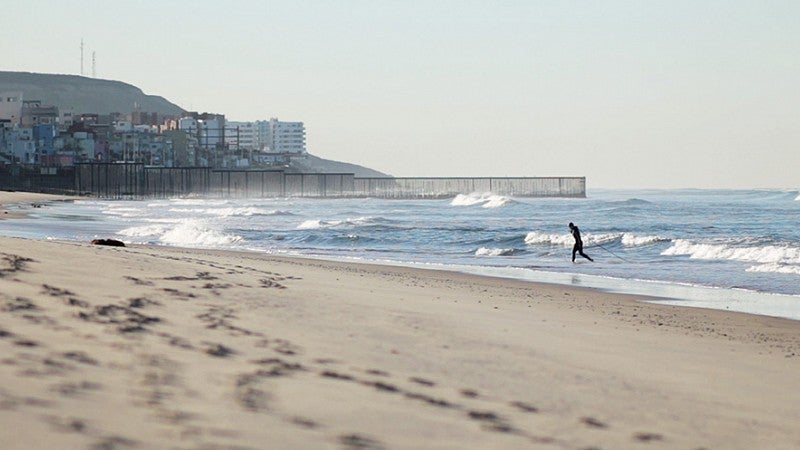Scene: Somewhere near the California/Mexico border the lonesome sound of a distant train whistle blows as two laborers begin a quest to create their own Internet network by laying dark fiber optic cable across continents.
Dark Fiber, a film/art installation created by School of Art + Design Assistant Professor David Rueter and art instructor Marissa Lee Benedict, has been selected for screening at the 2018 Biennale Architettura’s U.S. Pavilion. In the 10-minute film, Rueter and Benedict dig trenches, splice, bury, and hang cable as they traverse urban and industrial landscapes.
About three years ago, with a shared interest in engineering and technology, Rueter and Benedict began researching dark fiber—unused optical fiber infrastructures that can be sold off or leased to other companies to build private networks. Their research raised questions about who owns infrastructure and new technology and how one goes about creating his or her own network.
“We asked the political question: who controls those networks?” Rueter says. “I’d heard people saying, ‘Well, we’ll just have to build our own networks.’ We thought that impulse was really interesting, but it’s more complex than that. We wanted to find out what [doing that actually entailed].”
Iker Gil, assistant curator of the Biennale’s U.S Pavilion, who has followed Rueter’s work in Chicago since his graduate school days, invited Rueter and Benedict to participate because he felt that their piece fit well with this year’s theme of “Dimensions of Citizenship.” The film will be one of the “Transit Screening Lounge” collection of single-channel works exploring citizenship through a lens of movement.
“The School of Art + Design is incredibly fortunate to have David Rueter and Marissa Benedict as members of our faculty,” says Laura Vandenburgh, Head of the School of Art + Design. “The selection of their video project ‘Dark Fiber’ is a tremendous honor and a testament to the compelling ideas they are exploring.”

Called the “Olympics of the art world,” the Venice Biennale (La Biennale di Venezia) is the oldest and most prestigious cultural exhibition. Based at the Giardini park, it houses 30 permanent national pavilions. The first event was held in 1895 to celebrate the silver anniversary of King Umberto I and Margherita of Savoy, the Italian king and queen. It draws more than a quarter of a million visitors to see exhibits by artists, architects, and designers from more than 100 countries.
A unique feature of Rueter and Benedict’s project is that it can continue indefinitely. At each exhibition, Rueter and Benedict reshoot the ending to show the cable coming into the venue where the film is being screened. They will travel to Venice in March to shoot the new ending for the Biennale version.
“We always wanted this feeling [as if] it just walked into the gallery and it’s here for a second and then it’ll be gone; that it’s always walking. It’s always moving,” Benedict says. “And each time new footage enters the piece, it grows in very small ways.”
Though the film poses more questions than it answers, the artists hope it will provide opportunities for viewers to think about the broader ideas of ownership and what a network means to the community. “It’s tough not to have an answer,” Benedict says, “but that’s the wonderful thing that art can do.”
Above: Still frames from Rueter and Benedict’s film, Dark Fiber.
Story by Sharleen Nelson



